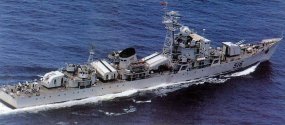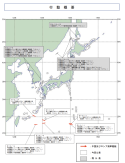Why do so many contemporary frigates worldwide have maximum speeds not even reaching thirty knots?
Would better engine systems drive the price up too much or are most navies concerned more with fuel efficiency?
To state the obvious: speed determines ability to change location in a given time-scale.
In more practical terms it defines the ability to
increase or decrease the range relative to your opponent. If you have higher speed than your opponent you will have freedom of maneuver and will retain
initiative. If the opponent has higher speed you will never have the initiative unless you achieve
surprise.
There are three fundamental time-scales to naval warfare, I'll classify them using land warfare terminology:
- strategic - ships moving between battle zones (logistics range)
- operational - ships moving in and out of battle zone (sensor range)
- tactical - ships moving in and out of combat (weapon range) within a battle zone
Anti-ship missiles are relatively new development with regards to the timeline of generations of warships. The first AShMs were Soviet but they were excessively large or had very limited range. P-15 Termit had 40km maximum range. MM38 Exocet introduced in 1975 had 40km range. Otomat and Harpoon had ranges over 100km but also slower speed compared to other traditional solid-fuel missiles like P-15 or MM38. Swedish RBS-15 had range of only 70km and was introduced in the 1980s.
This means that until late 1970s guns were the primary weapon of ships and aviation the primary long-range delivery system. Until late1980s torpedo boats were still a standard type of ship in naval service of many countries. For example Sweden and Norway had large fleets of torpedo boats that were partly re-armed with AShMs.
Furthermore warships that operated during the Cold War were built in successive generations:
- WW2 - designs from 1940s and 1950s
- post-WW2 - designs from 1950s and 1960s - introduction of modern radar
- early modern - designs from 1960s and 1970s - introduction of missiles
- modern - designs from 1980s and 1990s - introduction of multi-role function and modularity, helicopters become standard
Only the 1970s designs began to incorporate AShM but since most ships still followed tactical requirements of the era - e.g. a ship with purely ASW role or AAW role - it wasn't until the 1990s and 2000s that ship design began to reflect the new tactical reality with AShM as primary weapon and anti-air missiles, EW and VLO as countermeasures.
This means that it wasn't until the 1990s and 2000s that ship classes could be designed with new tactical requirements which also involved AShMs with ranges above 40kms.
This means that until that moment all ships had the option to use their speed at the tactical scale to move outside the weapons range whether artillery or short-ranged AShMs. Simple radar which on smaller ships is limited by horizon also played a role. If a ship could speed up to 30-40knots (55-75km/h) and move out of range or even break contact (sensor range) there would be no battle. This is why Soviet Tarantul missile boats which were built well into 1980s had 40knots top speed. By 1990s with proliferation of helicopters, improvements in radar technology and networking of sensors it stopped being a viable tactic because the missiles outranged the maneuver and newer radars became more accurate and effective at longer ranges.
At that moment top speed at tactical scale stopped being useful and instead high march speeds allowing to exploit the operational scale became a priority.
With the development of marine diesels the design of ship power-plants also changed. Initially steam turbines and gas turbines (COGAG) were the most viable method of propulsion. When high-power diesels became viable it changed the economics of ship construction. Diesels are extremely efficient at low speeds used for strategic marches or regular cruising - 14 to 21 knots. The standard method for speeding up was adding a gas turbine as a booster (CODAG) but that came at additional cost in space and money. When diesels became capable of reaching 27 knots it simply became too expensive for many classes of ships to include a gas turbine.
For example until the 1980s many ASW ships would need a top speed to be able to catch up with a submarine detected by a sonobuoy. After helicopters became commonplace it made more sense to move at lower (quieter) speeds while sending helicopters ahead of the ship.
Presently gas turbines are necessary for generating power in large warships - DDG and larger. But for smaller ships diesels are fully capable of generating power sufficient to propel at 26-27 knots which is really all that is necessary for a patrol frigate or an ASW ship.
The higher speed of a destroyer is really more of a consequence of having a more potent propulsion system. It can move at 30knots but it almost never does because maxing out the system also wears it out faster. The one exception are ships intended for CVN excort - those need the top speed because a nuclear-powered carrier has a high top speed and is also a key target, the only one that still uses speed at a "tactical" scale - for a carrier. So if the CVN moves at 30+ knots then so must its escort, especially the AAW destroyers.


